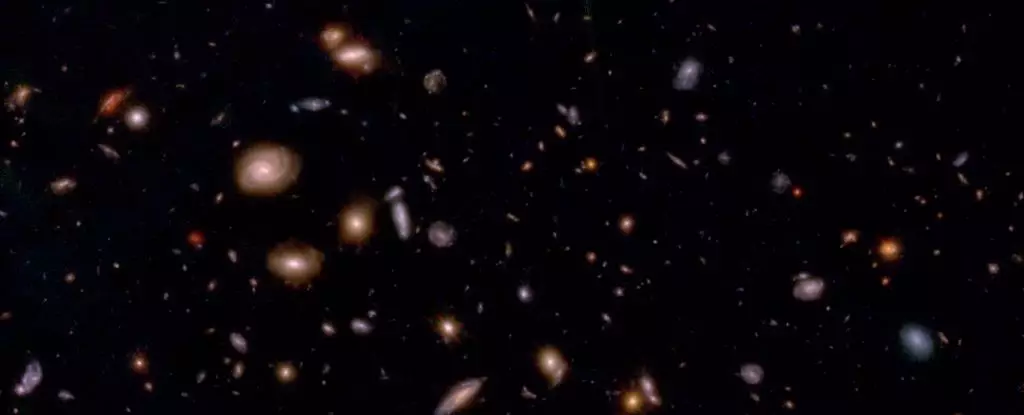The vastness of the universe is both mesmerizing and puzzling, presenting a realm filled with conundrums that challenge our understanding of cosmic mechanics. In recent astrophysical surveys, particularly through the advanced capabilities of the James Webb Space Telescope (JWST), astronomers have observed a striking alignment in the rotational directions of galaxies. Surprisingly, most galaxies appear to spin in a similar direction rather than exhibiting the chaotic rotation one might expect in an isotropic universe. This unexpected pattern has significant implications, suggesting that there is more than meets the eye in our understanding of cosmic phenomena.
Galactic Rotation Patterns: A Statistical Anomaly
Lior Shamir, an astronomer from Kansas State University, asserts that this phenomenon is more than a mere statistical hiccup; it raises fundamental questions about the nature of the universe itself. Under conventional cosmological models, one would anticipate a random distribution of galaxy spin directions. However, Shamir’s analysis indicates a marked skew, revealing larger numbers of galaxies rotating clockwise compared to their counterclockwise counterparts. This finding compels us to confront the limitations of our current theoretical frameworks and requires a deeper exploration into potential complexities governing cosmic behavior.
During Shamir’s investigation, 263 galaxies were scrutinized, their light having traveled several billion years to mend time and space. Surprisingly, the analysis demonstrated a notable discrepancy: 158 galaxies were found to rotate clockwise, while only 105 rotated counterclockwise. Such an imbalance calls into question the cosmological principle, which asserts that the universe is homogeneous and isotropic—uniform in all orientations. The implications of such a detailed exploration suggest not only that we might be miscalculating cosmological assumptions but also that our understanding of these celestial bodies’ movements could be fundamentally flawed.
Two Competing Theories: Birth or Illusion?
The core of the debate surrounding the observed galaxy rotations revolves around two competing hypotheses. The first proposition suggests that the universe itself may have been born with this peculiar rotational bias, perhaps as a consequence of being within a black hole—a concept that aligns with burgeoning theories in black hole cosmology. If true, this would illustrate grave insufficiencies in our current understanding and necessitate a paradigm shift in astrophysical models.
Conversely, the second hypothesis posits a more terrestrial explanation: the rotational influence of our own Milky Way galaxy could artificially skew perceptions of distant galaxy movements. This intriguing proposition implies that our position in the universe may affect our observations in ways that were previously underestimated. If we are misconstruing this intrinsic rotational influence, it could unlock new avenues for understanding cosmic growth and expansion rates, potentially transforming our comprehension of the universe’s age and history.
The Impact of Dark Matter and Cosmic Structures
As researchers dissect these puzzling findings, it is essential to consider the broader cosmic architecture, including vast filaments of dark matter forming an intricate network across the universe. These unseen structures create gravitational webs that bind galaxies and govern their interactions—among which rotation is a key factor. The unexpected rotational asymmetry may suggest that the underlying distribution of dark matter is not as uniform as previously believed, thus demanding further research into the fabric of cosmic connectivity.
What makes this revelation even more captivating is the possibility that our galaxy’s motion and location may not exist in isolation but rather intertwine with the dynamism of all neighboring celestial bodies. This intricate dance of gravitation could contribute to patterns that had previously gone unnoticed, indicating a deeper relationship between galaxies beyond the simplistic models that nature has deployed so far.
Challenging the Foundations of Cosmology
The implications of Shamir’s findings reverberate throughout the astrophysics community, indicating a profound need to revisit and potentially recalibrate many long-standing assumptions regarding cosmic behavior. If the Milky Way’s rotation significantly influences observations, scientists may need to reevaluate methodologies for distance measurement across the cosmos. In effect, recognizing and addressing these complexities lends an urgency and gravity to the ongoing pursuit of cosmic truths.
As we probe into the heart of these ageless mysteries, we stand at the precipice of a potential breakthrough that could advance our understanding of everything from the cosmic microwave background to the fundamental architecture of galaxies. The universe, with all its swirling galaxies, beckons us not just to observe but to reflect on the very nature of existence itself. The secrets hidden in the night sky may be waiting for us to uncover them.


Leave a Reply